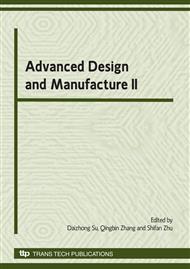p.457
p.461
p.465
p.469
p.473
p.477
p.481
p.485
p.489
Using Modal Analysis and Optimization to Determine Elastic Constants of Thick Composite Plates
Abstract:
This paper presents an inverse method to derive the elastic constants of thick composite plates from the resonance frequencies of a free-edge test specimen based on modal vibration test. A mixed numerical experimental identification procedure is used for this purpose. The sum of the squared differences between the experimental frequencies and analytical frequencies from finite element method is chosen as the objective function. The optimization techniques, Hybrid Genetic /Simulated Annealing algorithm, have been applied to determine the elastic constants. As the objective function reaches its minimum, its corresponding design variables are the elastic constants of the material. The present method is applied to determine the elastic constants of AS4/PEKK material. The results indicate that different stacking sequences and numbers of frequencies have effects on the determination of elastic constants of the materials.
Info:
Periodical:
Pages:
473-476
Citation:
Online since:
October 2009
Authors:
Price:
Сopyright:
© 2010 Trans Tech Publications Ltd. All Rights Reserved
Share:
Citation:


